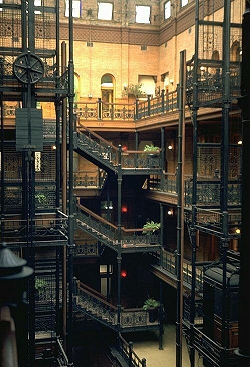|
Return To Menu Join Club BR RoundTable Check Your E-Mail Join ICQ Contact Us |
 The Online Blade Runner Fan Club |
 |
||||
The use of the Bradbury was one of the major deciding factors in making Blade Runner take
place in Los Angeles. It was the familiarity of the landmark that made others
convince Ridley that if he were to use it in the film, he would have to make it LA.

The following is an exerpt from Michael Connely's book "Angels in Flight"
"The Bradbury was the dusty jewel of downtown. Built more than a century
before, its beauty was old but still brighter and more enduring than any
of the glass-and-marble towers that dwarfed it like a phalanx of brutish
guards surrounding a beautiful child. Its ornate lines and glazed tile
surfaces had withstood the betrayal of both man and nature. It had
survived earthquakes and riots, periods of abandonment and decay, and
a city that often didn't bother to safeguard what little culture and
roots it had. Bosch believed there wasn't a more beautiful structure
in the city � despite the reasons he had been inside it over the years.
 To Bosch, the IAD was the only blemish on the building's beauty.
Twice he had faced Board of Rights hearings in the Bradbury.
Each time he gave his testimony, listened to witnesses and an IAD
investigator � once it had been Chastain � report the facts and
findings of the case, and then paced the floor beneath the atrium's
huge glass skylight while the three captains privately decided his fate.
He had come out okay after both hearings and in the process had come to
love the Bradbury with its Mexican tile floors, wrought-iron filigree and
suspended mail chutes. He had once taken the time to look up its history
at the Los Angeles Conservancy offices, and found one of the more intriguing
mysteries of Los Angeles: the Bradbury, for all its lasting glory, had been
designed by a $5-a-week draftsman. George Wyman had no degree in architecture
and no prior credits as a designer when he drew the plans for the building
in 1892, yet his design would see fruition in a structure that would last
more than a century and cause generations of architects to marvel. To
add to the mystery, Wyman never again designed a building of any significance,
in Los Angeles or anywhere else."
To Bosch, the IAD was the only blemish on the building's beauty.
Twice he had faced Board of Rights hearings in the Bradbury.
Each time he gave his testimony, listened to witnesses and an IAD
investigator � once it had been Chastain � report the facts and
findings of the case, and then paced the floor beneath the atrium's
huge glass skylight while the three captains privately decided his fate.
He had come out okay after both hearings and in the process had come to
love the Bradbury with its Mexican tile floors, wrought-iron filigree and
suspended mail chutes. He had once taken the time to look up its history
at the Los Angeles Conservancy offices, and found one of the more intriguing
mysteries of Los Angeles: the Bradbury, for all its lasting glory, had been
designed by a $5-a-week draftsman. George Wyman had no degree in architecture
and no prior credits as a designer when he drew the plans for the building
in 1892, yet his design would see fruition in a structure that would last
more than a century and cause generations of architects to marvel. To
add to the mystery, Wyman never again designed a building of any significance,
in Los Angeles or anywhere else."
|
||||||
| Return To Menu - Join Club - Check Your E-Mail - Join ICQ - Contact Us | ||||||



